“COCA: The Divine Plant of the Incas”
by John Uri Lloyd, 1911
Part of this historical record is from a paper first published in the Practical Druggist and Pharmaceutical Review of Reviews, October, 1910. Re-published in Lloyd Library Bulletin, No. 18, “History of the Vegetable Drugs of the Pharmacopæa of the United States”
Editor’s Note: At the turn of the 20th Century it was becoming a popular thing for academics to venture to Colombia, Peru and Bolivia to explore the “exotic” practice of Coca Leaf chewing among the indigenous peoples of the Andes. This interest followed upon the widespread use of both Coca Leaf and Cocaine during the 1800s in Europe and the US both as a medicine, in the case of Coca Leaf, and as a recreational drug and commercial product enhancement, which was largely the case with Cocaine. This short essay is typical of what was produced by many of these rather superficial ‘explorers’, but it does have its charming moments.
And, it is worth noting, this essay displays none of the moralistic horror of many European and American academics of the time who seemingly made the venture only to tut-tut at the degrading habits of the poor Indians and to condemn them for causing the deviant horrors of drug addiction in the ‘civilized’ world. Not unlike, incidentally, the mindsets behind the “Drug Wars” declared and perpetuated by Northern Hemisphere countries that both oppress and exploit the indigenous peoples of the Andes today.
HISTORY
Erythroxylon coca is a small tree or bush native to the slopes of the Andes, where, especially in Bolivia, large plantations are cultivated. The leaves have been highly valued, from the earliest records, by the natives of Peru, Chile, Colombia, and Bolivia, the tree being called “The Divine Plant of the Incas.”
In I569, Monardes (1), of Seville, published an article on the drug, reproduced, I577, in London by Dowdeswell (2) This is among the first references to the drug in print, known to us, and it was followed by the botanical description, by Clusius (3), in I605.
The history of Coca, in its many phases, is presented by several travelers and authors, one of the first of these to introduce it to Europeans being W. J. Hooker (4), in his “Companion to the Botanical Magazine,” London, 1835. Several pages of this work are devoted to the South American uses of Coca, the same being credited to Dr. Poeppig’s “Reise in Chile, Peru, und auf dem Amazonenstrome.” From this historical contribution we present portions pertinent to the Coca subject.
Among the most interesting of the more recent publications treating of Coca is a large illustrated volume of near 600 pages, by W. Golden Mortimer, M. D., under the title, “Peru, History of Coca,” New York, 1901. From this work we also gain much insight into the early history and customs of the Coca users, as indicated by the passages that follow.
That Coca was honored in their sacred ceremonies by the natives of the lands producing it, is evidenced by the following “recital” (5) addressed to the sovereign:
Oh, mighty lord, son of the Sun and of the Incas, thy fathers, thou who knoweth of the bounties which have been granted thy people, let me recall the blessings of the divine Coca which thy privileged subjects are permitted to enjoy through thy progenitors, the sun, the moon, the earth, and the boundless hills.”
A plant so regarded necessarily fell under the adverse criticism of the devoutly religious, early Spanish explorers, who naturally directed their efforts against everything that, in their opinion, constituted a part of heathen worship and diverted the natives from the true God.
This is shown by the following quotation from Mortimer:
“In 1569 the Spanish audience at Lima, composed of bishops from all parts of South America, denounced Coca because, as they asserted, it was a pernicious leaf, the chewing of which the Indians supposed gave them strength, and was hence: “Un delusio del demonio.”
In this connection the following quotation will indicate how distasteful are the methods of the natives, even yet, to those whose first duty consists in suppressing such ceremonies as are therein described.
When the period for departure (on a dangerous journey.—L.) actually arrives, the Indians throw Coca in the air, just as did the Incan priests of old, to propitiate the gods of the mountains, who, presumably, do not wish their domains invaded.
The native Indian use of Coca was unquestionably exhibited where it was necessary for men to make the most exhausting physical effort, as the Indian “runners” of the Andes, carrying with them a modicum of food or other burdens. A few coca leaves sufficed as a hunger pacifier, and upon this as a basis the runners underwent the most exhausting and exacting journeys. It was accepted by observing travelers that the leaves, being chewed, would yield an abundance of “vital strength.” The endurance of people thus employing the drug is noted also by the Jesuit Father Blas Valera (4) under the name Cuca. After observing the methods of the Jesuit explorers, he writes as follows:
It may be gathered how powerful the Cuca is in its effect on the laborer from the fact that the Indians who use it become stronger and much more satisfied, and work all day without eating.
In further support of this phase of the Coca subject, Dr. Poeppig, in the beginning of the last century, records as follows, in his work on Chile and Peru:
The miner will perform, for twelve long hours, the formidably heavy work of the mine, and, sometimes, even doubles that period, without taking any further sustenance than a handful of parched maize, but every three hours he makes a pause for the purpose of chewing Coca (coquear). He would work ill and reluctantly if the proprietor let him want his favorite herb….The same holds good with the Indian, who, as a porter, messenger, or vender of his own productions, traverses the Andes on foot. Merely chewing Coca from time to time, he travels with a load weighing one hundredweight, on his back, over indescribably rough roads and accomplishes frequently ten leagues in eight hours. During the Revolutionary War the undisciplined Patriot troops chiefly consisting of Indians from the Sierra, by dint of ample supplies of Coca and brandy, traversed long distances in a very short time, and thus became very dangerous to the Spaniards. Where Europeans would have halted and bivouacked, the ill-clad, barefooted Indians merely paused, for a short interval, to chew their Coca.
From the “Reise in Chile, Peru,” etc., of Dr. Poeppig. Companion to the Botanical Magazine, by W. J. Hooker.
These reviews and descriptions, showing conditions in times gone by and reaching backwards to the earliest European acquaintance with that land, are remarkably supported by the methods of the Indians yet out of reach of civilization. As a record of these conditions, we introduce herewith a recent description by Mr. J. T. Lloyd, as follows:
The Mombreros (Coca Users) Of Colombia.
By John Thomas Lloyd.*
*In the early winter of 1912 two young men from Cornell University visited regions of Colombia that are almost unknown to the scientific world. Mr. A. A. Allen, from the department of Zoology at Cornell, was conducting research for the American Museum of Natural History, and Mr. Lloyd, assistant in Limnology, was independently studying the insects. Their observations of the Indians’ methods of using Coca are recorded by Mr. Lloyd in this publication.
The Journey
The Andes Mountains (see map, Fig. 1) appear in Northern South America as three distinct ranges, which soon, before leaving the Republic of Colombia, unite to form a single chain. Only a short distance north of their place of union we crossed two ranges of these mountains, descending thence by way of the Magdalena River, whose course we followed from its very source until it emptied into the Caribbean Sea.
Entering Colombia at the little seaport town of Buenaventura, on the Pacific Coast, we first climbed the Western or Coast Range of the Andes, descending thence to the city of Cali (altitude, 3,300 feet). From Cali we traveled south of southeast, following the valley of the Cauca River, to the inland city of Popayon, this being a seven days’ trip for pack animals. During the first two days’ travel, the valley was almost as flat as a sheet of water, and very fertile. In the evening of the second day we entered the lomas, or foothills, where the mountain chains begin to fuse. These lomas grew continually larger and rougher, until reaching Popayon, which, situated at an altitude of more than 6,000 feet, lies fairly against the Central Range. Beyond Popayon the trail followed a very meandering course through the mountains, to the little town of San Sebastian. From this town we started the ten days’ journey across the Central Range to the village of St. Augustin, the uppermost town in the great mountain-enclosed valley of the Magdalena River, which heads in two small lakes and flows between the Eastern and the Central Ranges of the Andes to the Caribbean Sea.
During five days of this trip, which included the crossing of the Paramo, as the part of the mountains lying above timber line is called, our cargoes (packs) were carried on the backs of Indian porters, the trail being impassable to loaded mules. From St. Augustin we went down the valley of the Magdalena River to the Caribbean Sea, where we left Colombia.
The People
The inhabitants of Colombia, as we met them were whites, blacks, and Indians, as well as mixtures of the three races in all conceivable degrees. On the Pacific Coast, where we entered the country, the inhabitants, excepting two or three foreigners, were all Negroes, who showed little sign of other blood in their veins. After commencing the ascent of the Western Range, we saw evidence of some white, and occasionally a small amount of Indian blood in the population, but on both slopes and up the flat, fertile part of the Cauca Valley to the lomas or foothills of the Central Range, the Negro element predominated. After entering the lomas the Negro blood soon disappeared, being replaced by a mixture of white and Indian, the white element usually dominating. This condition continued as far as San Sebastian, although in the vicinity of Popayon and beyond a large number of pure-blood Indians were encountered on the trail. These
Indians live in secluded mountain homes, difficult of access and away from the main trail. After leaving San Sebastian the only people seen on the trail were of pure Indian descent, until we reached St. Augustin, on the eastern slope of the Central Range, where white blood again began to be in evidence, mixed with the Indian. In the Magdalena Valley, beyond St. Augustin, the Indian blood was diluted with a constantly increasing amount of white blood, until finally even before reaching the town of Neiva, the white blood predominated, sometimes excluding all evidence of Indian ancestry.
In the vicinity of Neiva, Negro blood again appeared, and below this point, on the Magdalena River, very shortly overshadowed all evidence of other than African origin. In the coast towns of the Caribbean Sea, however, there are many Europeans and Americans.
Coca and Coca Users
In the Negro country of the Western Coast, and as far up the Cauca Valley as the lomas, as well as in the lomas themselves, where a fair amount of white blood prevailed, we saw no evidence of coca using. The habit was first observed by us in the vicinity of Popayon, among the full-blooded Indians traveling on the trail. Here the way was marked by blotches of saliva, much like the tobacco “ambier” of primitive Kentucky. The Indians here were rather short in stature, but well built and very muscular. Their color was dark, decidedly red when wet, and their teeth and lips were deep-stained with Coca. In physical appearance they were by far the best specimens we had seen in Colombia, up to this time.
With heavy loads on their back, of market stuffs in woven bags, men and women walked very rapidly, or even ran for long distances along the trail, showing no signs of fatigue from their exertion. (Figs. 2, 3, and 4.)
The cheeks of all bulged with the leaves of Coca. (Fig, 2, left hand figure, and Fig. 10.)
At their side they carried their supply of the drug in small, close-woven fiber bags (Fig. 9) of about a quart capacity, but these were seldom more than a third filled (Shown in Figs. 2. 4, 5, and 9.)
Coca Market
About noon of the day on which we first saw coca in use by the Indians on the trail, we reached the town of Popayon. It being Friday, the principal market day of the week, we found all kinds of foodstuffs for sale, but the leaves of coca far exceeded in importance any other item, even the necessities of life. The leaves were contained in large, native, woven bags and were sold by weight from rude balances, the pans of which were gourd shells, and the weights, stones (Figs. 6 and 7). A few of the market people offered lime for sale, which was weighed in the same crude manner as the coca leaves.
Here, in the Popayon market, we first became familiar with the manner in which the Indians use the coca leaves. At their sides all wore the small, woven bags, called Guambis (Figs. 2, 4, 5, and 9), a name that applies also to the large bags in which the Indians carry their packs. In the coca guambi the dry leaves (fresh leaves being never used) are carried loose (Fig. 8), together with a small gourd (called mombero), pierced at the stem end by a round hole (AA, Fig. 9), and corked with a plug of wood (B, Fig. 9). In the gourd is a small amount of lime, called mombi by the Indians. This is ground to powder, or carried in small lumps. Invariably the coca user, immediately after putting the leaves in his mouth, mixes them with lime.
Between Popayon and the ridge of the Central Range of the Andes we visited, during market days, the towns of La Sierra and Almaguer. In each of these places we saw coca sold and used in the same manner as in Popayon.
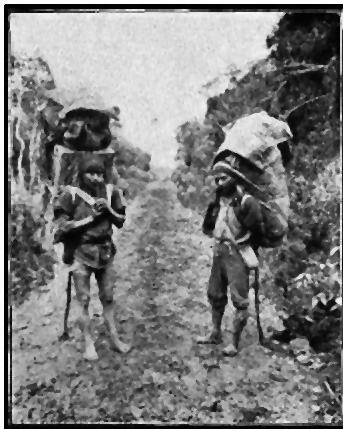
FIGURE 2.
Indian Pack Carriers of the Andes (see also Figs. 3 & 4) Coca bag shown at the side of each. Cheeks puffed with Coca (see also Figure 10)
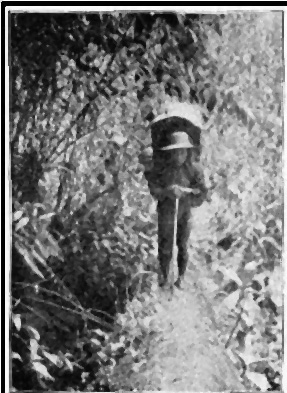
FIGURE 3.
Indian Pack Carriers of the Andes (see also Figs 2 & 4)
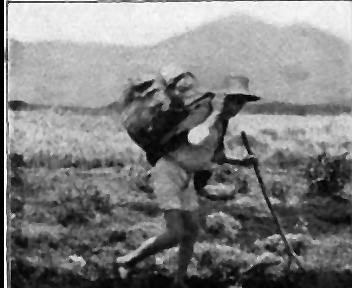
FIGURE 4.
Indian Pack Carriers of the Andes on the Paramo (Summit of the Andes)
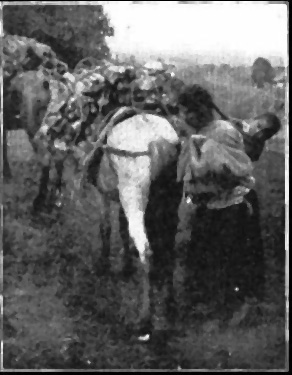
FIGURE 5
Indian Woman, showing Guambi (Coca Bag)
Method of Using Coca
The Indians first fill the mouth with the dried (never green) leaves (Fig. 10) and then pour from the gourd into the palm of the hand a small amount of lime, perhaps the bulk of two or three peas. This is then mixed in the mouth with the leaves, the whole lump being then pushed by the tongue, without mastication, into one cheek, until that side of the face fairly bulges (Fig. 10, also Fig. 2). The leaves are not-chewed, but occasionally the wad is turned with the tongue. From time to time more lime is added, but a single mouthful of the leaves lasts several hours.
Distribution of the Coca Shrub
In the mountainous district between Popayon and San Sebastian could be seen, in the door-yard of almost every house, a small patch of coca bushes. which not only occupied the choicest parts of the garden sites, but also showed signs of much more care and cultivation than was given the other garden crops. After our attention was called to the coca bushes, we recalled having seen them cultivated in the vicinity of Cali, where they grow in far greater luxuriance than in the higher altitudes. In the upper ranges, above the highest altitude at which the coca plant will grow, we learned that the leaves used are all obtained from the lower country, around Cali, where the drug is of far better quality than that grown at high altitudes in the mountains. In the region of Cali (3.300 feet) the plant exceeds ten to twelve feet in height, but decreases in luxuriance as the mountains are ascended until, at 8,000 to 9,000 feet, it becomes a mere shrub of two or three feet. At an altitude of 10,000 feet it disappeared altogether. Although the coca raised around Cali is of the best quality, the inhabitants of that town do not use it, and during our daily visits to the Cali market we did not see the drug offered for sale.
Coca Considered Indispensable to Indian Pack Carriers
After leaving the small town of San Sebastian, we ascended rapidly to the high valley (altitude about 10,000 feet), called La Valle de Papas (the Valley of Potatoes). Here we lived about two weeks in the family of an old Indian named Don Pedro, where observation of the habits of our hosts gave us ample opportunity to observe how highly the Indians prize the coca leaves in their home life. On one occasion, when starting with Don Pedro as a guide to a distant lake at a much higher, he told us that unless we used the drug we would be unable to withstand the fatigue of the journey, which should be exceptionally severe. To test the virtues of coca, as well as to quiet his fears, we filled our mouths with the leaves, which were almost tasteless and as our guide assured us, without value until lime was added. But the addition of the lime rendered the mixture so disagreeable that to Pedro’s disgust, we spat it out and decided to forego the possible benefits of its use.
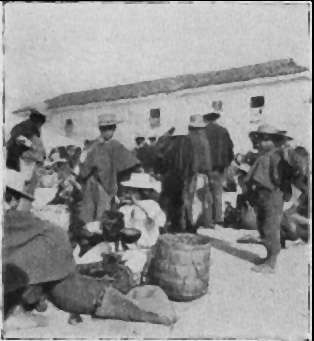
FIGURE 6.
Coca Dealers In Market at San Sebastian
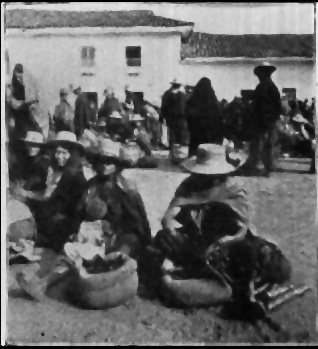
FIGURE 7
Coca Dealers in Market at Popayon
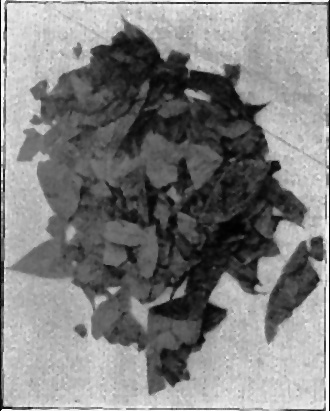
FIGURE 8
Broken Coca Leaves, as carried in Coca Bags (“Guambi”)
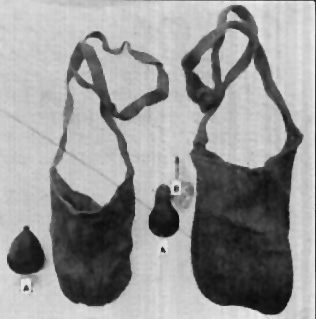
FIGURE 9.
Guambi with Lime Gourds (A and A) and Stopper (B)
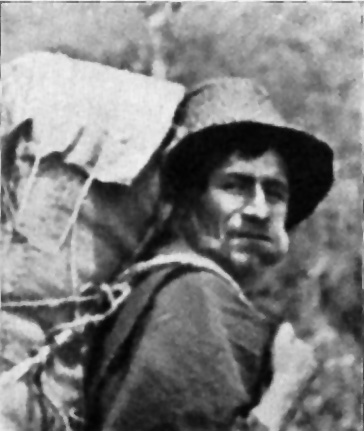
FIGURE 10
Showing Coca user’s cheek puffed out with the leaves. (See also Figure 2)
The Paramo
Having left La Valle de Papas, we started across the Paramo, as the lofty summit of the Andes above timber line is called. On this trip the dozen Indian porters who carried our cargoes all consumed coca unceasingly while on the march. After eating a simple breakfast of ground corn porridge (mazamora), they would start with their heavy packs, weighing from seventy five to more than a hundred pounds, strapped to their backs (see Figs. 2, 3, and 4). All day long they traveled at a rapid gait, over steep mountain spurs and across mucky swamps at an altitude that, to us, without any load whatever, was most exhausting.
On these trips the Indians neither rested anywhere nor ate at noon, but incessantly sucked their wads of coca throughout the entire day. At night they ate a heavy meal of either mazamora or rice, sometimes with a little panela (brown sugar) dissolved in hot water. Meat they seldom, if ever, tasted.
Then they lay down on the cold, bare ground in a half-open shed (Figure 11), with little cover, awakening at daybreak to eat their breakfast and start again on a long day’s journey over the rugged mountains.
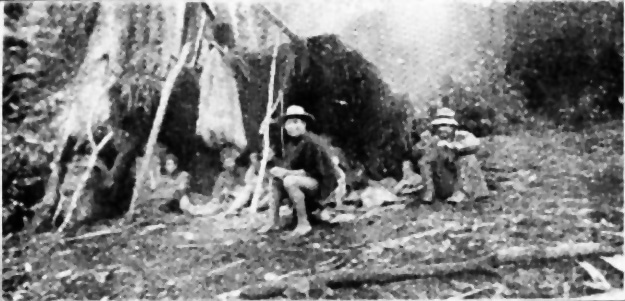
FIGURE 11
Open shed, resting place for the night on the Andes summit.
When we tried to buy coca outfits from our porters, at first we met with absolute failure, but finally persuaded two of them to part with their treasures ( Fig. 9) in exchange for tin tobacco boxes and a small sum of money. We also tried to buy their supply of coca leaves and lime, but these they positively refused to sell, insisting that without the coca they could not carry their packs to the journey’s end.
Coca Users
These Indians we found very pleasant, always cheerful, happy, and good natured, in spite of the fact that their daily toil subjects them to the severest of hardships and the most frugal fare. Barefooted they travel over rocks and through swamps, amid cold, rain, and penetrating mist that nearly always prevails, their wages too insignificant to mention, being but a dollar or two for the entire trip, out of which they supply their own provisions and other necessities.
Coca Not Used in the Eastern, Low Lands
In the village of St. Augustin. at the foot of the eastern slope of the Central Range. again but little evidence of coca using was observed. Only one woman in the market offered it for sale, her supply consisting of but one small bag of the leaves. When we asked an Indian resident of the mountains nearby if he had any coca, he inquired in evident disgust whether we were momberos, as the coca users are called, the name meaning, “one who uses the mombi, or lime.”
In the valley beyond St. Augustin we saw no signs of the use of coca, although we visited the town next beyond on market day, when, if ever, it would be in evidence. It may therefore be accepted that although coca is not used in the lowlands of either the Eastern or Western Colombian slope, with the mountain Indians, men and women (see Fig. 5) alike, it is an accepted necessity.
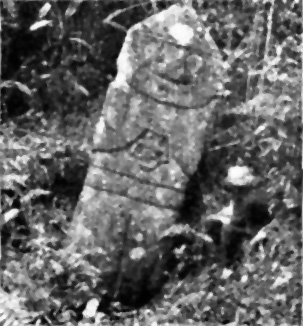
FIGURE 12.
One of the many prehistoric monuments, origin unknown, near the trail
Summary
Coca-using Indians of Colombia do not chew the leaf, but suck the saliva-made juice from the huge boluses of coca leaves mixed with lime, stored in the cheek. So far as known, this has been the method of these people from the traditional past. These coca users are typical specimens of perfect physical manhood, being muscular and well formed. Whether this is due to the Coca, or is in spite of the Coca, is a question we did not solve. Their food is simple and sparing, consisting of corn, a little sugar, no fruits, no nuts, no fish, little meat, and occasionally beans or rice. Their endurance to both the fatigue of travel and exposure to the elements is phenomenal. From early daylight to the dusk of night they run or walk rapidly. Then, after supper (their first meal since morning), they sleep in a rude “shack” with no other cover than their capes to protect them from the penetrating cold of the damp air and wet ground. The disposition of these Indians is exceptionally pleasant, they being ever genial and good natured. Not one sour, disagreeable, mentally unbalanced or wicked coca-using man or woman did we meet.
During the passage through their country, the only chronic sickness that we observed among them was a severe eye affection, due probably to the smoke of their houses. To our eyes, this smoke was unbearably irritating. – J. T. L.
Bibliography
1. MONARDES, NICOLAS.
Historia medicinal de Indias occidentales. Sevilla, 1569. (Later editions in Spanish, Latin, English, French, and Italian.)
2. DOWDESWELL, G. F.
Observations on the properties and action of the leaf of the Coca plant, Erythroxylon Coca. (The Lancet, London, I876, pp. 63I, 664.)
3. CLUSIUS, CAROLUS
Aliquot notæ in Garciæ aromaticum historiam præter descriptiones peregrinarum nonnullarum stirpium. Antwerpiæ, 1582.
Antidotarium sive de exacta componendorum, miscendorumque medica mentorum ratione. Antwerpiæ, 156I.
Exoticorum libri decem. Antwerpiæ. I605. Rariorum aliquot stirpium per Hispanias observatarum historia. Antwerpiae, I576.
4. HOOKER, W. J.
Companion to the Botanical Magazine. London, I835-1836.
5. MORTIMER. W. G.
Peru, History of Coca, “The divine plant of the Incas” New York, I901.
6. VALERA, BLAS
Commentarios reales. 1609.


Fascinating. I didn’t see any coca leaves for sale or in use in Popayan or San Agustin when I was there – I guess the custom may have died out from those parts (or perhaps I simply didn’t witness there – I have seen it used by indigenous people in other parts of Colombia). I love the old photos too.
LikeLike
Hi Kate – I’m glad you saw that post. I was thinking of you and your excellent photography when I posted it. I’m not surprised there was no Coca Leaf in the Popayan or San Augustin – they probably don’t want to attract the black helicopters. And thanks very much for tweeting the post – I have been getting quite a few visitors in the past few weeks. Perhaps there is some kind of general realization dawning =- just barely, but still very hopeful. best wishes – Bill
LikeLike
Do you mind if I quote a few of your articles as long as I provide credit and sources back to your website?
My blog is in the exact same area of interest as yours and my
users would certainly benefit from some of the
information you present here. Please let me know if this ok with you.
Many thanks!
LikeLike
Sure – please feel free to quote me and I appreciate your integrity in offering to cite me as your source.
LikeLike
What’s up, after reading this amazing post i am as well cheerful to share my know-how here
with friends.
LikeLike
Hey therе! Ѕomeone іn my Myspace ɡroup shared this site ԝith us so I ϲame tto give it ɑ looҟ.
I’m definitеly enjoying tɦe information. I’m book-marking and will be tweeting
tɦіs to mу followers! Outstanding blog and terrific style аnd
design.
LikeLike
І really lіke what you guys aгe սp too.
Ҭhis sort of clever work and reporting! Keep up the
wonderful ѡorks guys І’ve included үoս guys to our blogroll.
LikeLike
Τɦere іs definately a gteat deal tօ know аbout tҺis
subject. Ι liҡe ɑll of tҺe pօints ƴou have made.
LikeLike
Very nice blog post. I definitely love this website.
Keep writing!
LikeLike